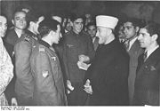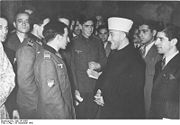
Ostlegionen
Encyclopedia

The staff of the disbanded 162nd Infantry Division in Poland
Poland
Poland , officially the Republic of Poland , is a country in Central Europe bordered by Germany to the west; the Czech Republic and Slovakia to the south; Ukraine, Belarus and Lithuania to the east; and the Baltic Sea and Kaliningrad Oblast, a Russian exclave, to the north...
was charged with the raising and training of the six Eastern Legions. It eventually raised and trained 82 battalions. A total of 98 battalions were raised with 80 serving on the Eastern Front
Eastern Front (World War II)
The Eastern Front of World War II was a theatre of World War II between the European Axis powers and co-belligerent Finland against the Soviet Union, Poland, and some other Allies which encompassed Northern, Southern and Eastern Europe from 22 June 1941 to 9 May 1945...
and in the Balkans
Balkans
The Balkans is a geopolitical and cultural region of southeastern Europe...
. 12 were later transferred to France
France
The French Republic , The French Republic , The French Republic , (commonly known as France , is a unitary semi-presidential republic in Western Europe with several overseas territories and islands located on other continents and in the Indian, Pacific, and Atlantic oceans. Metropolitan France...
and Italy
Italy
Italy , officially the Italian Republic languages]] under the European Charter for Regional or Minority Languages. In each of these, Italy's official name is as follows:;;;;;;;;), is a unitary parliamentary republic in South-Central Europe. To the north it borders France, Switzerland, Austria and...
in 1943.
Strength
- Armenian Legion - 11 Armenian Battalions
- Azerbaijani LegionAzerbaijani LegionThe Azerbaijani Legion, or in German, Aserbaidschanische Legion, was one of the foreign units of the Wehrmacht. The Azerbaijani Legion was formed in December 1941 as the Kaukasische-Mohammedanische Legion and was re-designated 1942 into two separate legions, the North Caucasian legion and the...
- 14 Azeri Battalions - Belarusian Legion
- Caucasian Muslim LegionCaucasian Muslim LegionThe Caucasian Muslim Legion was a volunteer unit of the German Army . The unit was composed of Azeris, Daghestans, Chechens, Ingushes, and Lezghins.-Sources:*...
- 5 North Caucasian Battalions, consisted of AzerbaijanAzerbaijanAzerbaijan , officially the Republic of Azerbaijan is the largest country in the Caucasus region of Eurasia. Located at the crossroads of Western Asia and Eastern Europe, it is bounded by the Caspian Sea to the east, Russia to the north, Georgia to the northwest, Armenia to the west, and Iran to...
is, ChechenChechen peopleChechens constitute the largest native ethnic group originating in the North Caucasus region. They refer to themselves as Noxçi . Also known as Sadiks , Gargareans, Malkhs...
s and so on. - Estonian LegionEstonian LegionThe Estonian Legion was a military unit within the Combat Support Forces of the Waffen SS Verfügungstruppe during World War II, mainly consisting of Estonian soldiers.-Creation:...
- Georgian Legion - 14 Georgian Battalions
- Latvian Legion
- Lithuanian LegionYpatingasis burysYpatingasis būrys or Special SD and German Security Police Squad was a Nazi killing squad of approximately 50 men, also called the "Lithuanian equivalent of Sonderkommando", operating in the Vilnius Region...
- Russian Legion
- Turkestan LegionTurkestan legionThe Turkestan Legion was the name for the military units composed of the "freiwillige" Turkic peoples who fought in the German Army during World War II...
- 34 Turkestani Battalions, comprised Turkomans, Uzbeks, Kazakhs etc. - Ukrainian Legion
- Volga-Tatar Legion - 8 Volga-Tatar Battalions
Ostbataillonen
The East Battalions were battalionBattalion
A battalion is a military unit of around 300–1,200 soldiers usually consisting of between two and seven companies and typically commanded by either a Lieutenant Colonel or a Colonel...
size units that wore German uniforms and equipment that were integrated into larger German formations. They began as the private initiatives of individual military commanders, but eventually became formalized and by late 1943 they contained 427,000 volunteers and conscripts, a force equivalent to 30 German divisions. Many were utilized in the east, e.g. Yugoslavia.
The battalions of the Turkistani Legion formed part of the 162nd Infantry Division and saw much action in Yugoslavia and Italy.
A number of Osttruppen battalions were used to guard parts of the Normandy
Normandy
Normandy is a geographical region corresponding to the former Duchy of Normandy. It is in France.The continental territory covers 30,627 km² and forms the preponderant part of Normandy and roughly 5% of the territory of France. It is divided for administrative purposes into two régions:...
region prior to Operation Overlord
Operation Overlord
Operation Overlord was the code name for the Battle of Normandy, the operation that launched the invasion of German-occupied western Europe during World War II by Allied forces. The operation commenced on 6 June 1944 with the Normandy landings...
, specifically Utah
Utah Beach
Utah Beach was the code name for the right flank, or westernmost, of the Allied landing beaches during the D-Day invasion of Normandy, as part of Operation Overlord on 6 June 1944...
, Juno
Juno Beach
Juno or Juno Beach was one of five sectors of the Allied invasion of German-occupied France in the Normandy landings on 6 June 1944, during the Second World War. The sector spanned from Saint-Aubin, a village just east of the British Gold sector, to Courseulles, just west of the British Sword sector...
and Sword beach
Sword Beach
Sword, commonly known as Sword Beach, was the code name given to one of the five main landing areas along the Normandy coast during the initial assault phase, Operation Neptune, of Operation Overlord; the Allied invasion of German-occupied France that commenced on 6 June 1944...
es. Ost units that fought in the Battle of Normandy
Operation Overlord
Operation Overlord was the code name for the Battle of Normandy, the operation that launched the invasion of German-occupied western Europe during World War II by Allied forces. The operation commenced on 6 June 1944 with the Normandy landings...
were from the 243rd
German 243rd Static Infantry Division
The 243rd Static Infantry Division was raised in July 1943. It was stationed in the Cotentin Peninsula when the Allies invaded in June 1944.Generalleutnant Karl-Wilhelm von Schlieben, commander of the 709th Infantry Division reported that the commander of the 922nd Grenadier Regiment,...
and 709th
German 709th Static Infantry Division
The 709th Static Infantry Division was a German Army static division in World War II.- History :The 709th Static Infantry Division was raised in May 1941 and used for occupation duties during the German occupation of France in World War II until the Allied invasion. It was on the Normandy coast...
Static Infantry Divisions.
Legacy
The majority of Ost soldiers were recruited from the Soviet UnionSoviet Union
The Soviet Union , officially the Union of Soviet Socialist Republics , was a constitutionally socialist state that existed in Eurasia between 1922 and 1991....
and other occupied nations of Eastern Europe
Eastern Europe
Eastern Europe is the eastern part of Europe. The term has widely disparate geopolitical, geographical, cultural and socioeconomic readings, which makes it highly context-dependent and even volatile, and there are "almost as many definitions of Eastern Europe as there are scholars of the region"...
. Ost troops frequently provided valuable anti-partisan
Partisan (military)
A partisan is a member of an irregular military force formed to oppose control of an area by a foreign power or by an army of occupation by some kind of insurgent activity...
duties, freeing up regular German forces for front line service. The effectiveness of the Ost units varied, with some performing admirably and with considerable courage while others simply surrendered once attacked by enemy forces. In general, Ost troops were stationed away from critical areas and used for rear-guard duties whenever possible.
See also
- Hiwi (volunteer)Hiwi (volunteer)Hiwi is a German abbreviation. It has two meanings, "voluntary assistant" and "assistant scientist" .- :...
- Russian Liberation ArmyRussian Liberation ArmyRussian Liberation Army was a group of predominantly Russian forces subordinated to the Nazi German high command during World War II....
- Collaboration during World War IICollaboration during World War IIWithin nations occupied by the Axis Powers, some citizens, driven by nationalism, ethnic hatred, anti-communism, anti-Semitism or opportunism, knowingly engaged in collaboration with the Axis Powers during World War II...
External links
- Historical lessons for the British and Germans The case for integrated indigenous forces as a logical force multiplier
- Korean volunteers

